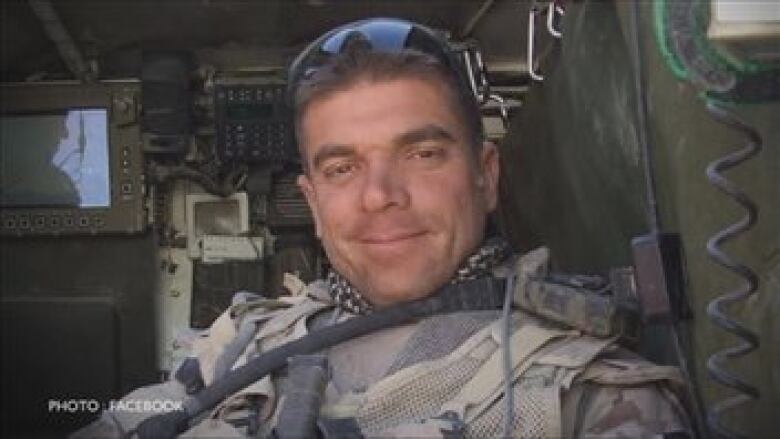Canadian soldier suicides poorly tracked, veterans groups say
Canadian Armed Forces, Veterans Affairs do not not track suicides by retired soldiers

The recent deaths of two Canadian soldiers who fought in Afghanistan have renewed public debate about how to deal with military suicides. But veterans advocates say that the data collected by the Canadian Armed Forces and Veterans Affairs Canada on how many active and retired army personnel have committed suicide is incomplete, and makes it difficult to help soldiers who may be suffering from post-traumatic stress disorder (PTSD).
“If you don’t have all the data, then how are you able to determine the causes and address some of the trends?” says Bruce Poulin, communications manager for Dominion Command of the Royal Canadian Legion in Ottawa.
Canada’s Department of National Defence (DND) has confirmed that two soldiers died in the past week.
Corporal Alain Lacasse, 43, of Valcartier, Que., was found dead in his home on March 17. Police said it was a suicide.
Master Cpl. Tyson Washburn, 37, of Pembroke, Ont., was found dead on March 15. Officials aren't releasing details about his death, but CBC News has learned Washburn appears to have taken his own life.
- 2 soldiers who served in Afghanistan found dead
- 3 Canadian veterans from Afghan war found dead in a week
There has been a spate of soldier suicides in recent months, including three in the span of three days in November.
Three more soldiers died in January. On Jan. 3, Cpl. Adam Eckhardt, a native of Trenton, Ont. who was based with the Princess Patricia’s Canadian Light Infantry at CFB Suffield in Alberta, was found dead.

On Jan. 8, Cpl. Camilo Sanhueza-Martinez, a member of The Princess of Wales’ Own Regiment based in Kingston, Ont., who had fought in Afghanistan, was found dead.
On Jan. 16, Lt.-Col. Stephane Beauchemin, a 22-year veteran who had been deployed to Haiti and Bosnia, died in Limoges, Ont, a small town east of Ottawa.
The deaths of Master Cpl. Washburn and Cpl. Lacasse bring the number of confirmed suicides of Canadian soldiers in 2014 to five.
The difficulty of getting accurate numbers
The Canadian Armed Forces (CAF) has published figures on soldier suicides up to and including 2012. The numbers show there were 10 suicides in 2012, 21 in 2011 and 12 in 2010.
Poulin says the figures published by the CAF are incomplete, because they only look at men currently serving in the forces and do not include army reservists, those who have retired from the military, or women.
According to the CAF website, “the low number of suicides amongst female CAF members makes the statistical analysis of female rates unreliable.”
The CAF has not published numbers for 2013, but according to Nicole Meszaros, a senior public affairs officer for the Canadian Armed Forces, “in the calendar year 2013, the CAF lost nine members to suicide and another four members whose deaths are under investigation but remain to be officially confirmed as suicide.”
Of the nine confirmed suicides in 2013 cited by Meszaros, one was a woman and three were reservists. Those numbers do not include veterans no longer serving in the military.
A ‘disingenuous’ comparison
The published CAF figures show that over the period of 2005-2009, the suicide rate was 18 deaths per 100,000. This rate is comparable to that for males in the civilian population. According to Statistics Canada figures from 2009, the suicide rate for Canadian males was 17.3.
Poulin says that historically, the official suicide rate for serving soldiers is about 20 for every 100,000 but adds that it's not a complete picture of what's happening.
“By not counting women, reservists and those that leave the military, you’re still looking at 20,” says Poulin. “The question then becomes, OK, but is that an accurate reflection of PTSD and the situation that we are facing right now?”
A 2013 report published by the Department of National Defence found that suicide rates in the CAF have not increased over time, and after age standardization, were lower than those in the Canadian civilian population.
That comparison is “disingenuous,” says Michael Blais, CEO and director of Canadian Veterans Advocacy.
“These men and women are not like those in the [civilian] population,” says Blais. He points out that soldiers are recruited for their mental toughness, and that anything that might trigger a suicide was “not a pre-existing condition – it’s a wound.”
“To compare a wound that was sustained in a military environment to the [psychological difficulties of someone in the] civilian population, that doesn’t cut it,” he says.
'Veterans Affairs has an obligation'
While he takes issue with the suicide figures presented by CAF, Blais says it’s equally concerning that there is no data on the number of veterans who commit suicide after leaving the military.
“We have people who are getting out [of service], and within a year, committing suicide,” says Blais. “So many times, you find out about a suicide literally months after it’s happened.”
The Canadian Armed Forces does not keep track of suicides by retired soldiers, and Blais says neither does Veterans Affairs. CBC made several interview requests to Veterans Affairs, but did not receive a comment.
Blais says that the lack of documentation of suicide among retired veterans hinders efforts to get a proper handle on the scope of PTSD.
“Veterans Affairs has an obligation – we can’t fix this unless we know what’s wrong,” he says.
With files from Kazi Stastna